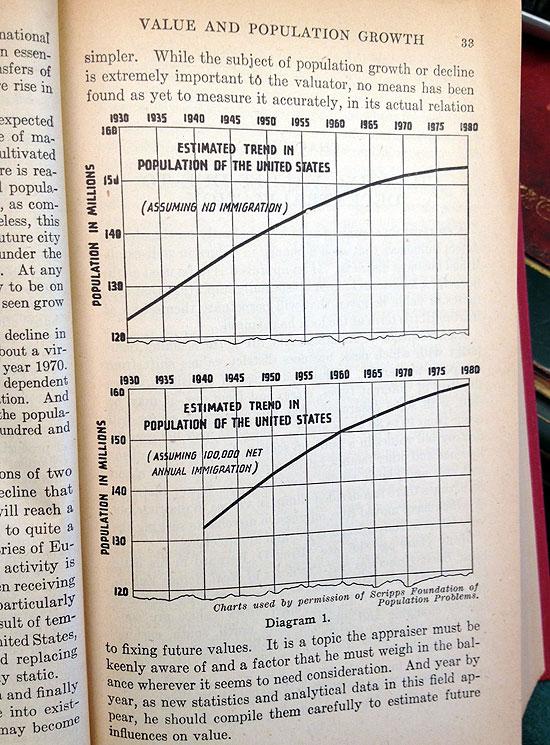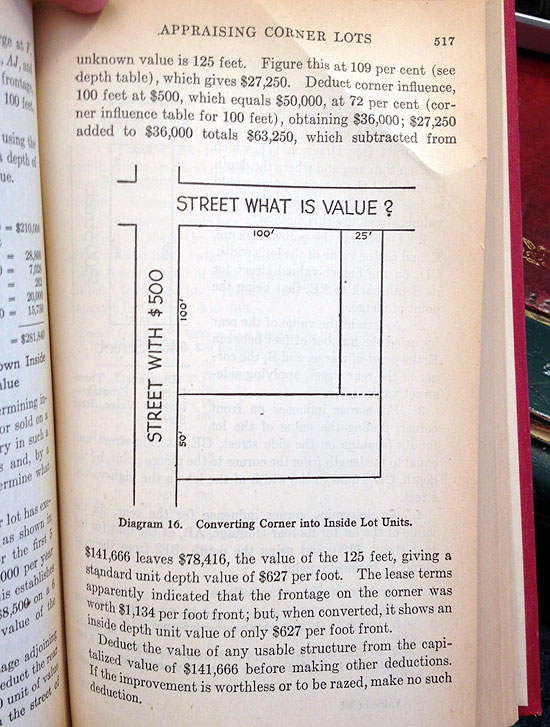I did something fun and picked up another old-school book to review today :) McMichael’s Appraising Manual by Stanley L. McMichael. 3rd edition circa 1948 – shortly after World War II.
Only this time around it wasn’t nearly as fun as last month’s Thrift book we reviewed, unless you’re a diehard real estate fan and/or master appraiser, haha… (I picked it up on impulse thinking it was gonna cover a bunch of different topics, but sadly it was only real estate… Though I did learn another important lesson here besides taking my time before purchases: NEVER GO SHOPPING WITH A CRYING BABY!! YOU GET NO TIME BEFORE PURCHASES! ;))
Still, it did keep my attention for a solid half hour at least, so I thought it was still worth sharing with you fine people. Especially the parts on what “value” means to people. I had no idea there were so many definitions – and types – of value out there! Or, that after World War II The U.S. had debt as much as $200,000,000,000 and more! At least according to the book… Which was then followed by a section on how “there will be insistent demands for new houses, apartments, automobiles, and household equipment and furnishings, as well as all kinds of consumer goods” in order to “maintain America’s standard of living.” 60 years later and it still hasn’t stopped, eh?
Here was my favorite clip from the entire book. AKA the beginning because I almost fell asleep after chapter two ;)
In every transaction which price is involved, four elements influence the amount of the price:
- The value of goods to the seller.
- The value of goods to the buyer.
- The value of money to the buyer.
- The value of money to the seller.
Since these elements constitute the fundamentals of the law of supply and demand, variation of any of them causes a change in price.
How true, right? We all value “things” and money differently, so when two people meet to do a transaction, naturally there will be some sort of disconnect. But when both parties are equally happy, a lovely deal is made and they both walk away feeling like they won! Which I guess is why yard sales are so damn exciting for both sides of the deals – one gets rid of “junk” and the other gives pennies on the dollar for “treasure.” Win-win!
I also learned that price and value are never static. And that “normalcy in real estate is difficult, perhaps impossible, to find.” Since the market continually swings from booms to depressions and then back again. (Though I feel like “normalcy” would be fairly constant at least smack in the middle of each period, yeah? Like during the booms prices would be high, and then during the depressions they’d switch to being low? Until things turn back one direction or the other? But I’m no scholar, of course…)
I then got a schooling on all the different measurements of value.
We’ll start with a quote from Alfred D. Bernard that I thought was pretty interesting:
“Value of bread is expressed in need; the value of a glittering diamond is expressed in desire. The value of real estate is often the expression of both or either”
Which then led to a plethora of other different meanings and types of values. All compiled from a variety of people and places too – which I assume were the best definitions the author could find on such topics:
Market value: “The quantity of other commodities a property will command in exchange: specifically, the amount expressed in terms of money which a purchaser would be justified in paying for a property as of a certain date, assuming he were to acquire thereby all the rights and benefits to the equivalent extent possessed by the owner.”
Speculative value “is actually not a value at all but the price an owner hopes someone will pay for his property on a rising price market. It is created through booms, high-pressure selling, rapid growth of a city, entrance of large new business enterprises into a community, construction of a new railroad, discovery of oil or minerals, and other abnormal but natural factors.”
Sentimental value “attaches to properties held by old families or owners who for reasons of personal attachment do not desire to part with their holdings. It is no basis on which to determine market value.”
Absorption value “is the value attributed to a small inside property, sandwiched between large and important building enterprises, which earns an abnormal rental per square foot as compared to adjoining property by reason of the intensive use to which it may be put.”
Nuisance value “is really not a value at all but actually a minus element and a term applied to a condition creating a nuisance which limits the value of a property itself or of its neighbors, or both.”
Tangible value is “practically the same thing as intrinsic value or economic value.”
Pretty pictures and graphs!
It was at this point I stopped reading and started skimming :) All the way to the end where the pretty pictures and graphs were, haha… Here’s a sampling of what I saw:
Chapters I never got to:
Most of the chapters were what you’d expect to see in a real estate appraisal handbook (“Appraising Homes,” “Depreciation,” “Compensation For The Appraiser,” etc) but a couple did stand out more than others… Perhaps you can guess which? ;)
- “Testifying in Court”
- “Appraising Gasoline Stations”
- “Evaluating Timberland, Shade and Fruit Trees”
- “Determining Value in Foreign and In Negro Neighborhoods”
Today’s Takeaways:
- Don’t buy books while babysitting
- Everyone values property differently
- Everyone values money differently
- The real estate market isn’t ever “normal”
- Old books are still awesome, even for mere eye candy
At $6.00 I’ll take the lessons learned and call it a wash :) Though let me just point out that the theory on how most money principles stay the same over the years is still very much valid! As evidence in both this book, and the last (more fascinating) one we reviewed simply titled “Thrift.” If you haven’t checked it out yet, I highly advise you do. That ones dates back to the late 1800’s!
I’d like to leave you with one last clip from the book, if I may. This one coming from the legend himself, Mr. Confucius, 500 years before the birth of Christ. Even further proving that money principles hold true over the years:
“The value of thy property” said Confucius to his scholar, “dependeth upon thy neighbor!”
So be sure to treat them well! :)
Get blog posts automatically emailed to you!







I’d probably read then skim like you although as the son of a “foreigner” I’d probably read the foreigner chapter too… That title certainly jumped out. Interesting to think whether a 2014 version would go there…
Yeah, def. interesting?
See how much wiser people were before iPhones and Flappy Bird to occupy their time? Too deep for my Tuesday morning.
It is amazing how the value of certain goods and items can be so different between individuals. We recently did an exercise at work where we were asked to all quote the same project. The differences were 3X the lowest to the highest. Ironically we ended up getting the project at the higher price. So it just goes to show how much money we leave on the table when we put a price to something.
Oh wow… Probably goes for negotiating salaries and the like too!
Page 517 had me going cross eyed…put your right foot in, put your right foot out, jump 6 times, slap your neighbor and WA-LA…you have value. Lol! I would have donated it right after buying it. Ha!
Haha… the whole thing had me cross eyed for the most part ;)
Funnee, Catina. Now you’ve given me an earworm of the Hokey Pokey that’ll probably nag me all day. But since it’s pick on Mr. McMichael time, I’ll jump in with a critique of his population prognostication on Page 33 of 160,000,000 by 1960 when it actually zoomed to over 225,000,000 (so sez wikipedia). But wait, as J$ told us, he was just showing the “pretty pictures and graphs.” No fair reading text;)
Correction: my fact checker (Richard Anthony) informs me that the 1960 U.S. population was closer to 180,000,000 (again, wikipedia), so apologies to Mr. McMichael for only being off by 20,000,000 . . .
You’ve got a lot of time on your hands right now, don’t you? ;)
I find these old books so interesting, J$. I’ll have to snoop around more at the antique shops for books. :-)
Do it! But then make sure to blog about it :)
“NEVER GO SHOPPING WITH A CRYING BABY!! YOU GET NO TIME BEFORE PURCHASES!” Just wait til you add #2 to the mix! I can’t remember the last time I bought a book while out with the kiddos – it just doesn’t happen. :) That said, those are definitely some interesting chapter titles! ;)
Oh man, I’m so afraid, haha… I can barely handle one!
Ageless:
“The value of goods to the seller.
The value of goods to the buyer.
The value of money to the buyer.
The value of money to the seller.”
So makes you wonder if we need appraisers at all?Oops… that’s what hubby does… ahem…True simple story illustrating that point though:
One of my kids has a name with variable spellings and how hers is spelled is one of the least common. We were were in Mexico and one of those beach vendors wanted to sell me a name on a grain of rice. Well since I can never buy her anything pre-printed with her name on it (key chains etc.) and the concept was pretty cool, I proceeded with my negotiations. I got to $7 which was worth it for me, plus I liked the guy. (Some of those beach vendors can be so persistent and annoying) Both happy – win-win!
So hubby came along as I was completing the purchase and said I paid too much for that. He figured I ‘got taken’ and reminded me periodically throughout the week. He felt that since I only came down from his price by about 30% it was not a good deal. I said it was worth it for me and I was quite happy with my purchase. “Value of goods to the buyer”.
So he learned to like talking to the vendors on the beach. Plus he was interested in buying a blanket. So he negotiated with a guy and got it down more than 60% and was bragging to me about the great deal he got at around $16 bucks equivalent from $40. Well, wouldn’t you know it, when we went to town we saw many vendors selling the same blankets at $10.
Not sure how it fits into the 4 lines above so I’d like to add my own:
The value of savvy in the seller
The value of stupidity in the buyer
HAH! Love it! And as long as you’re happy in the end, that’s all that matters, right?
Just wait until baby number 2 comes along. “Don’t buy books while babysitting”
I think you just come up with your next blog idea. This not to do while watching the kids… :)
I even tried taking him to the kid’s book section but he didn’t seem to enjoy that too much. Must be too young still :)
Value is one of my favorite concepts. I tried to touch on this with that post you featured in Rockstar Finance (thanks, again!) but there’s a whole lot more to this. The nuisance value idea may be my favorite of the bunch. We should really consider adding that into rental real estate valuations, because they’re definitely a pain in the ass sometimes…
AGREED.
My mom always said that the worth of our money depends on the faith of the public to our government and their assumptions of our future as a country. It makes sense that value would depend on several things. Cool book and the not buying stuff while babysitting is good advice. :-)
Hmmm… perhaps that’s how the rest of the world views our money (and how we view theirs) but not sure I care much about that faith when buying and selling personally :) It’s not like we have many options for cash really! Haha… Well, at least besides bitcoin.
I didn’t know there was an actual term for “absorption value”! Very interesting. I wonder if the same term can be used to describe a situation where a certain lot or parcel of land is worth more to a neighbor than to a random buyer. I.e. in theory 100 acres of cattle grazing land is worth more to someone that already owns adjoining land than to someone new to the area. The new person could buy land anywhere, but the existing neighbor has limited options for acquiring adjacent land.
Good point! I bet there’s a specific term for that type of value too. I only pulled a handful from the 5 whole pages that were listed but it’s def. something to consider!
As I learn more about real estate investing, I was struck by a strange phenomenon. Houses with up to 4 units in them are appraised at a value based on comparable houses in the area and what they have sold for recently. It is a bit of an estimate/guessing game, really.
However, if you have 5 or more units, the property is looked at as purely an investment and the value is based on how much income it generates.
I thought that was an interesting distinction (and potentially arbitrary)!
That IS interesting! You learn a lot when you’re out there in “the wild” poking around, don’t you? :)
I love old books! So interesting to see those different values. You are so right that value and price are never static.
Yard sales are exciting — but I do prefer to be the seller. It’s fascinating in general how much of finance really just comes down to personal bias. What seems like a lot of money to me may not to another person or vice versa because of our specific upbringings. I appreciate that the value of a diamond is said to be expressed in desire. The general cost of diamonds seems so insanely inflated simply because of various monopolies in the industry, but I probably shouldn’t get off on a tangent.
Is there something you’d like to tell us, Miss. Diamond lover? ;)
Old books are always fun to sift through. Never know what you’ll find in a big pile. I like trying to find the oldest possible book in the place and see what it is about.
Yeah! So fun! Even better is what you sometimes find INSIDE the book, like notes or old envelopes, etc :) In fact, I just picked up a few older books at yard sales this last weekend that had some notes in them. Perhaps I’ll blog about them when I do my next “yard sale tips” post… Thx for the reminder!